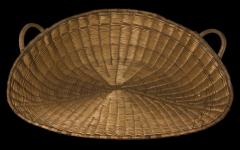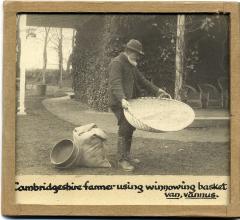ENGLAND: THE OTHER WITHIN
Analysing the English Collections at the Pitt Rivers Museum
English artefacts purchased for the founding collection and Pitt Rivers Museum 1884-2008
Alison Petch,
Researcher 'The Other Within' project
Much museum collecting is passive. The museum is approached by a donor who wishes to give an artefact, or series of artefacts to the collections. The museum decides whether it has the space, or inclination, to accept it and the artefact comes into the collection. Occasionally the museum takes a slightly more active role - asking known collectors whether they would be prepared to donate their collections to the museum.
However, some acquisitions are more actively sought. Some museums have very large acquisition funds that allow them to purchase collections or artefacts they are particularly interested in. There are also public sources of funding for particularly sought-after objects. The Pitt Rivers Museum has never really had much money for acquisitions, but over time it has acquired some artefacts specifically for its collections. Because of the active, positive, nature of these acquisitions it is interesting to consider what might have prompted the interest in the specific items or collections.
This section of the website gives details of the artefacts that have been acquired by purchase by the Museum since 1884. It also gives the same data for the founding collection, that is for artefacts acquired by Augustus Henry Lane Fox Pitt Rivers from auction houses or dealers for his English collections which were donated as part of the founding collection in 1884 to the University of Oxford.
English items purchased by Pitt Rivers and part of the founding collection, up to 1884
English items purchased by the Pitt Rivers Museum since 1884
Of course, it is possible to identify a category of 'passive purchases' and some of the items identified in the above pages must come into this category. A 'passive purchase' is one where the seller approaches the museum independently but wants to sell the artefact rather than donate it, for whatever reason. We would not be greatly interested in this category of artefacts, if we could identify them clearly, but this is not always possible. It seems likely that most purchases from private individuals probably fall into this category whilst many purchases from dealers are more directly activated by the Museum - that is, the Museum approaches the dealer or at least actively pursues the sale. It seems probable that all purchases from auction houses are actively pursued by the Museum. In both latter cases, however, the initial approach to the Museum could have been made by the Museum. Many dealers and auction houses seek to have close relationships with Museums, particularly if (unlike the Pitt Rivers Museum) they have large purchase funds. To enhance the relationship they will alert the museum to artefacts that they think will be of interest. To find out more about passive and active relationships with vendors see:
Sellers to the PRM Part 1, Part 2, Part 3, Part 4
Sellers to Augustus Henry Lane Fox Pitt Rivers
In addition, information is given about Pitt Rivers' relationship generally with donors and vendors here.
Sources
It will be seen that both the Museum and Pitt Rivers purchased artefacts from a fairly limited number of sources, basically an assortment of dealers and auction houses, mostly based in London. A list of all the people who sold items to the Pitt Rivers Museum is given here. A list of people who sold English items to Pitt Rivers for the founding collection is given here.
Pitt Rivers bought many objects for his collection, a discussion of this can be found here.
Statistics about purchases of English objects by the Museum
Contextualising English purchases
To contextualise the purchase of English objects by the Pitt Rivers Museum against the wider picture of the purchases from all over the world a single year has been examined, 1912. See here for further information.
Preliminary conclusion are to be found here.

